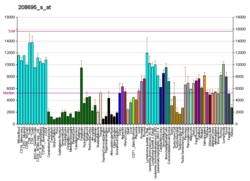60S ribosomal protein L39
60S ribosomal protein L39 is a protein that in humans is encoded by the RPL39 gene.[5][6]
Ribosomes, the organelles that catalyze protein synthesis, consist of a small 40S subunit and a large 60S subunit. Together these subunits are composed of 4 RNA species and approximately 80 structurally distinct proteins. This gene encodes a ribosomal protein that is a component of the 60S subunit. The protein belongs to the S39E family of ribosomal proteins. It is located in the cytoplasm. In rat, the protein is the smallest, and one of the most basic, proteins of the ribosome. This gene is co-transcribed with the U69 small nucleolar RNA gene, which is located in its second intron. As is typical for genes encoding ribosomal proteins, there are multiple processed pseudogenes of this gene dispersed through the genome.[6]
References
- 1 2 3 GRCh38: Ensembl release 89: ENSG00000198918 - Ensembl, May 2017
- 1 2 3 GRCm38: Ensembl release 89: ENSMUSG00000079641 - Ensembl, May 2017
- ↑ "Human PubMed Reference:".
- ↑ "Mouse PubMed Reference:".
- ↑ Otsuka S, Tanaka M, Saito S, Yoshimoto K, Itakura M (Sep 1996). "Molecular cloning of a cDNA encoding human ribosomal protein L39". Biochim Biophys Acta. 1308 (2): 119–21. doi:10.1016/0167-4781(96)00106-6. PMID 8764829.
- 1 2 "Entrez Gene: RPL39 ribosomal protein L39".
Further reading
- Wool IG, Chan YL, Glück A (1996). "Structure and evolution of mammalian ribosomal proteins". Biochem. Cell Biol. 73 (11–12): 933–47. doi:10.1139/o95-101. PMID 8722009.
- Gerhard DS, Wagner L, Feingold EA, et al. (2004). "The Status, Quality, and Expansion of the NIH Full-Length cDNA Project: The Mammalian Gene Collection (MGC)". Genome Res. 14 (10B): 2121–7. doi:10.1101/gr.2596504. PMC 528928. PMID 15489334.
- Strausberg RL, Feingold EA, Grouse LH, et al. (2003). "Generation and initial analysis of more than 15,000 full-length human and mouse cDNA sequences". Proc. Natl. Acad. Sci. U.S.A. 99 (26): 16899–903. doi:10.1073/pnas.242603899. PMC 139241. PMID 12477932.
- Yoshihama M, Uechi T, Asakawa S, et al. (2002). "The Human Ribosomal Protein Genes: Sequencing and Comparative Analysis of 73 Genes". Genome Res. 12 (3): 379–90. doi:10.1101/gr.214202. PMC 155282. PMID 11875025.
- Uechi T, Tanaka T, Kenmochi N (2001). "A complete map of the human ribosomal protein genes: assignment of 80 genes to the cytogenetic map and implications for human disorders". Genomics. 72 (3): 223–30. doi:10.1006/geno.2000.6470. PMID 11401437.
- Tsui SK, Lee SM, Fung KP, et al. (1997). "Primary structures and sequence analysis of human ribosomal proteins L39 and S27". Biochem. Mol. Biol. Int. 40 (3): 611–6. doi:10.1080/15216549600201203. PMID 8908372.
- Kato S, Sekine S, Oh SW, et al. (1995). "Construction of a human full-length cDNA bank". Gene. 150 (2): 243–50. doi:10.1016/0378-1119(94)90433-2. PMID 7821789.




